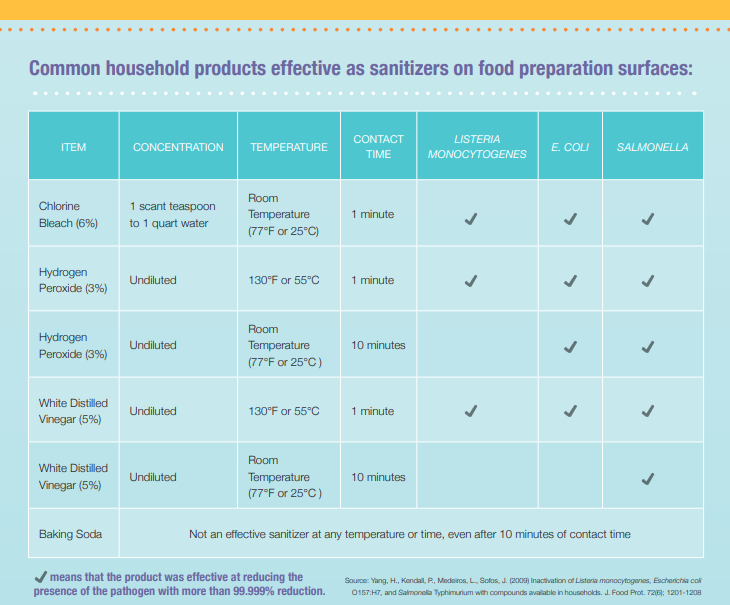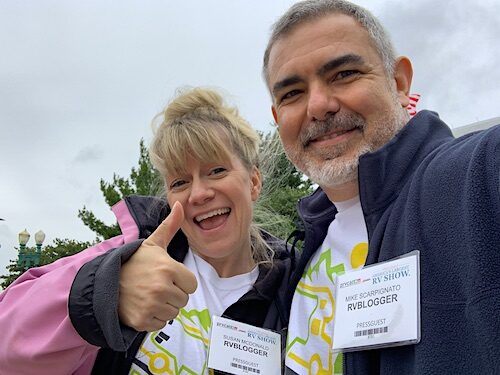Thanks for your support! If you make a purchase using our links in this article, we may make a commission. And, as an Amazon Associate, I earn from qualifying purchases. See the full disclosure here.
Updated April 11, 2024
Can I Sanitize My RV Water Tank With Vinegar?
I was reading through some RV forums recently, and I saw quite a few questions from people who were wondering if they could sanitize their RV water tank and lines with vinegar instead of bleach.
More and more people seem to be looking for ways to go green to help protect the environment. Susan uses white vinegar to clean all kinds of things around the RV, like carpet stains and the shower surround.
Of course, there were many questions and many more opinions on the subject. So, we did a little research ourselves and here is what we discovered.
Is Sanitizing the RV Water Tank and System With Vinegar Safe and Effective?
Sanitizing your RV fresh water tank and system with white vinegar is safe and effective. The graph below compares Chlorine Bleach, Hydrogen Peroxide, White Vinegar, and Baking Soda to determine which product is best at killing Listeria, E. Coli and Salmonella. As you can see, Bleach, Peroxide, and Vinegar kill all three types of bacteria.
BUT—and for most of us, this is a BIG BUT—the chart below shows that in order to be effective, the hydrogen peroxide or white vinegar must be heated to at least 130 degrees to kill all three of the bacteria. They are not effective at room temperature.

If you would like to read the full article you can find it at here or visit: https://extension.colostate.edu/docs/pubs/foodnut/kitchen-sanitize.pdf.
How Do I Get Hot Vinegar into My RV Water Tank?
If you are asking this question, you really want to save the planet, and I commend you for it. There is a great answer to this question, however, and that is to use your RV’s hot water heater to heat the vinegar solution to over 130 degrees. The beauty of doing this is that it actually kills two birds with one stone.
In addition to sanitizing your freshwater system, hot white vinegar is also perfect for removing the mineral deposits that build up in your hot water tank and on its anode rod.
Let’s take your coffee pot as an example. Sometimes, you will notice white mineral deposits in your coffee maker. When this happens, the manufacturer recommends that you run white vinegar through the coffee maker to clean it.
It’s the same principle here. The coffee maker heats the vinegar solution, which cleans the mineral deposits from the coffee maker.
15 Steps to Sanitize Your RV Water Tank with Vinegar
I’m sure you are thinking – how do I get the hot water and vinegar solution from the hot water heater into the cold water lines in my RV? In order to heat the vinegar solution to run through your hot and cold lines, just follow these steps:
- Before you begin you will need a thread adapter to attach a garden hose to your RV kitchen faucet. You can order one from Amazon or pick one up at Home Depot or Lowes.
- Make sure your water heater is off.
- Set your water heater temperature to over 130 degrees while it is off.
- Drain all the water you can from your water system and hot water tank.
- Fill your fresh water tank with at least 15 gallons of a 50/50 solution of water and white vinegar.
- Open your kitchen faucet and run your water pump until water comes out and you smell vinegar.
- Turn the water off and turn on the water heater. The water will take at least 20 minutes to reach at least 130 degrees.
- While the water is heating attach a thread adapter to the kitchen faucet in your RV.
- Attach a garden hose to the thread adapter and run it to the freshwater fill-up outside of your RV.
- When the water is heated, turn on your water pump and run water through the hot side of the kitchen faucet. This will fill the freshwater holding tank with the hot white vinegar solution.
- Once your fresh water tank has hot water in it, you will run each fixture, one at a time, until you smell vinegar, then turn the fixture off and move to another. You should get hot water out of each fixture’s hot and cold sides. NOTE: You will run the cold side of the kitchen faucet last in this process.
- Don’t forget to run the solution through your ice maker, instant hot, or the drinking water dispenser in the fridge door.
- Once you have run the hot solution through every hot and cold line to every fixture, you can disconnect the garden hose and let the solution sit overnight.
- The next day, be sure your hot water heater is off. Remove the anode rod and drain and rinse out the water heater completely. You will probably see quite a bit of sediment when you do this. Re-insert the anode rod and then dial the hot water heating temperature setting back to 120 degrees. Please note that temperatures over 120 degrees can cause scalding.
- Hook up to a freshwater supply and run fresh water through both the hot and cold sides of all of your fixtures until the vinegar smell is gone.
Now, your entire freshwater system is sanitized and ready for use!
How Often Should I Sanitize My RV Water Tank and System?
You should sanitize your RV water system if your RV has been sitting for a long time. You definitely should sanitize every spring when you de-winterize your RV. Here are some other guidelines for when you should sanitize your freshwater system:
- If you notice a stale odor when using your water
- If your RV has been sitting for two weeks or more and the RV water system has not been used
- If you have been informed that there is a boil water advisory, it is definitely time to sanitize the entire water system.
- If you have algae or slime in your water tank, it is time to sanitize the entire water system.
Even though you do not drink water from your freshwater tank, you still need to sanitize your system. Bacteria will still form in the water system, and you don’t want to drink or take a shower in bacteria-filled water. Although filters will remove contaminants and improve taste and odor, they are not purifiers and will not kill bacteria.
Other Options for Sanitizing Your RV Water Tank
Another option to sanitize your RV Water tank and system is to use the Thetford Fresh Water Tank Sanitizer product. This leaves no bleach, taste, or smell. This two-part treatment system will help sanitize and deodorize the fresh water tank and all the plumbing lines.
So you could use it instead of bleach or vinegar and then flush the water lines out, saving a lot of time and hassle. Thetford Tank Sanitizer is safe for the environment, too!
UV Water Purification Systems for RVs (New 2024 Info)
Since writing this article in 2019 and then revising it in 2024, a new product has hit the RV market: a UV Water Purification System for RVs.
Residential UV Water Purification Systems have been around for a long time. I even installed one in my home in the late 1990s because I had well water, and the probability of bacteria in well water is much higher than in city water, which has chlorine to kill any bacteria.
They work by exposing your RV water to UV light through a special in-line chamber. The UV light kills any bacteria in the water. Now, these UV Water Purification Systems are available for your RV. I am in the process of installing one in our Class A RV, so stay tuned for a YouTube video about this process.
UV Water Purification Systems don’t sanitize your Freshwater tank through. They only kill bacteria in the water line that passes through the UV light.
There are two ways to install the UV Water Purification System. One is so it purifies all of the water in your RV, and the other is to only purify your drinking water.
Installing a UV Water Purification System that purifies all of the water in your RV is a little more expensive and difficult, but it is a great option.
For example, if you only purify the water that runs to your kitchen sink or refrigerator ice and water lines, the rest of your RV’s water could have bacteria in it.
And this is not a substitute for disinfecting your freshwater tank. We recommend you still disinfect your tank from time to time.
For more information about UV Water Purification Systems, check out our article Why UV Water Purification Systems for RVs are Vital.
Is It Practical to Sanitize Your RV Water Tank with Vinegar?
Cleaning your water tank and system without bleach definitely goes against conventional wisdom. But if your goal is to go green and be ecologically friendly, then a hot vinegar solution is a great choice. It takes a little extra work, but it is a pretty easy process if you have the kitchen sink thread adapter.
But it’s up to you if it is a practical solution.
RELATED READING: For more info about RVs check out our article The Pros and Cons of Owning an RV.
Thanks for reading this article and if you would like to contact us directly please feel free to visit our Contact Page and send us an email.
Learn More:
– How to Remove Antifreeze Taste and Smell from RV Water
– How to Remove the Plastic Taste from Your RV Water
– How to Sanitize Your RV Fresh Water Tank
– How to Store an RV Water Filter Between Trips
– Why UV Water Purification Systems for RVs are Vital
To see a list of all of our articles check out the Blog Archive!
Mike Scarpignato – Bio
Mike Scarpignato created RVBlogger.com over five years ago in 2018 to share all we have learned about RV camping.
Mike is an avid outdoorsman with decades of experience tent camping and traveling in his 2008 Gulf Stream Conquest Class C RV and 2021 Thor Challenger Class A motorhome.
We attend RV Shows and visit RV dealerships all across the country to tour and review drivable motorhomes and towable trailers to provide the best evaluations of these RVs in our blog articles and YouTube videos.
We are 3/4-time RVers who created RVBlogger.com to provide helpful information about all kinds of RVs and related products, gear, camping memberships, tips, hacks and advice.




“ Fill your fresh water tank with at least 15 gallons of a 50/50 solution of water and white vinegar.” Right! 7.5 gallons of vinegar.
If your unit came with heating pads for your tanks in winter why couldn’t you use the pad for the fresh water tank to heat the viniger solution. My book says it will heat up to 158 degrees, but I know some may not work if the outside temp isn’t below freezing .mine seem too work regardless of outside temp. Just an idea.
Mike, My Kitchen faucet is a hand sprayer that has no way to connect a hose to. Any thoughts? Love the article, Thx Patrice
Hi Patrice,
Without seeing your hand sprayer it is hard to say what you should do…but I would imagine you could buy some parts from Home Depot that could attach to your faucet…
Thanks for reading the article!
Mike
The hand sprayer most likely will have threads. Remove the sprayer and connect a hose there.
What is thread size for the faucet aerater adapter. Do the Camco threads match the threads of a dura faucet? Like everything else on an RV the thread size is not standard and “perpritary”
Thanks for the great information on using something other than Clorox to sanitize the rv water system.
I have not done it but it seems to me that one could use the hot water side of the outdoor shower (if you have one) to get the hot water into the cold water storage tank.
Just another option.
That is a great idea!
Thanks for your comment.
Mike
Perhaps a reminder about going green…. When flushing your system after a vinegar sanitization, the pH will be quite low (acidic) at the beginning. Don’t let it come in contact with vegetation e.g.,lawn at the side of a driveway, since it will kill most vegetation it comes in contact with. Also, don’t let it run down your local storm sewer. If you want to be green, collect it, dilute it with at least an equal amount of water and dispose of it in a municipal sanitary sewer.
Hi Dave,
Thanks for your comment! That is a really great point to share with anyone reading this post.
Thanks for sharing!
Mike
I would be very skeptical that you can keep the vinegar at 130 degs. when filling the fresh water tank with this method. It is bound to loose at least a few degrees in transfer from hot tank to fresh tank. And more in the fresh tank and on its way to fixtures.
Chlorine dissapates rapidly when exposed to air and then will not hurt the environment. This is the method you use to fill your fish aquarium. Just let it sit exposed overnight.
I would be afraid that the vinegar method wouldn’t do the job completely especially after sitting all winter.
I couldn’t agree more. I use chlorine to sanitize my tanks. But with so many folks going green I wanted to point out how that this method will not work unless the vinegar is at least 130 degrees and keeping vinegar at that temperature is difficult at best.
Thanks for reading the article!